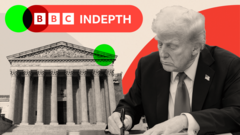In late May 2024, lower Manhattan buzzed with anticipation as the jury deliberated in Donald Trump's hush money trial regarding a payment to adult film star Stormy Daniels. I, alongside the BBC team, presumed a lengthy wait and opted for a lunch break at Katz's deli. Unexpectedly, chaos erupted—rumors swirled of a verdict's return. Just before the BBC News at Ten aired, I sprinted to the live report station, unintentionally smashing my phone on the pavement in my haste. When the verdicts emerged—guilty... guilty... guilty—a historic moment unfolded: a former president now a convicted felon.
As the US’s senior North America correspondent, I closely followed Trump's legal battles, now compounded by multiple criminal and civil cases that threaten his liberty and political future. Fast forward a year, and Trump's fortunes have shifted dramatically. Three pivotal Supreme Court decisions granted presidents greater immunity against prosecution, dismissing a ruling that attempted to bar Trump from future office due to election challenges, while also limiting lower courts’ ability to hinder presidential initiatives. With a revamped Supreme Court that solidified a conservative majority, Trump now aims to extend his influence over federal district judges, challenging their authority.
As judges voice their fears of unprecedented assaults stemming from Trump's administration, a dark narrative unfolds; threats of violence have escalated against those opposing executive decisions. Nancy Gertner, a former federal judge, noted a troubling rise in hostility towards judges, indicating they face threats unlike any seen previously, driven by the administration’s incendiary rhetoric.
Burdened by the pressure of public hostility, judges have reported receiving threats, with the US Marshals Service recording over 400 threats against nearly 300 judges by mid-June 2024. This hostility is particularly poignant for Judge Esther Salas, who has recently endured chilling threats linked to her late son’s tragic death.
Diatribes from Trump-affiliated officials frame the judiciary as obstructive to the people’s will, asserting that judges impede administrative intentions. This narrative of judicial obstruction misrepresents the roles outlined in the Constitution, stirring fears among legal experts that the balance of power is irreversibly altered.
Trump's reliance on executive orders has sparked confrontations with the judiciary, leading to numerous nationwide injunctions cutting across key constitutional issues. His administration's actions have been labeled as judicial overreach, igniting debates about the implications for governance and law adherence.
The tension surrounding the judiciary is palpable, raising profound questions about the future of checks and balances within US governance. Critics argue that the system is poised for a catastrophic shift, warning of an era where the whims of the presidency might overshadow the judiciary's authority.
Despite ongoing confrontations, the judiciary is resisting this tide. Following a Supreme Court ruling limiting nationwide injunctions, a new order blocked Trump’s controversial immigration actions, signaling the relentless tug-of-war between executive power and judicial independence. This ongoing battle carries unpredictable repercussions for the current administration and future presidencies, underscoring a pivotal moment in American democracy.
As the US’s senior North America correspondent, I closely followed Trump's legal battles, now compounded by multiple criminal and civil cases that threaten his liberty and political future. Fast forward a year, and Trump's fortunes have shifted dramatically. Three pivotal Supreme Court decisions granted presidents greater immunity against prosecution, dismissing a ruling that attempted to bar Trump from future office due to election challenges, while also limiting lower courts’ ability to hinder presidential initiatives. With a revamped Supreme Court that solidified a conservative majority, Trump now aims to extend his influence over federal district judges, challenging their authority.
As judges voice their fears of unprecedented assaults stemming from Trump's administration, a dark narrative unfolds; threats of violence have escalated against those opposing executive decisions. Nancy Gertner, a former federal judge, noted a troubling rise in hostility towards judges, indicating they face threats unlike any seen previously, driven by the administration’s incendiary rhetoric.
Burdened by the pressure of public hostility, judges have reported receiving threats, with the US Marshals Service recording over 400 threats against nearly 300 judges by mid-June 2024. This hostility is particularly poignant for Judge Esther Salas, who has recently endured chilling threats linked to her late son’s tragic death.
Diatribes from Trump-affiliated officials frame the judiciary as obstructive to the people’s will, asserting that judges impede administrative intentions. This narrative of judicial obstruction misrepresents the roles outlined in the Constitution, stirring fears among legal experts that the balance of power is irreversibly altered.
Trump's reliance on executive orders has sparked confrontations with the judiciary, leading to numerous nationwide injunctions cutting across key constitutional issues. His administration's actions have been labeled as judicial overreach, igniting debates about the implications for governance and law adherence.
The tension surrounding the judiciary is palpable, raising profound questions about the future of checks and balances within US governance. Critics argue that the system is poised for a catastrophic shift, warning of an era where the whims of the presidency might overshadow the judiciary's authority.
Despite ongoing confrontations, the judiciary is resisting this tide. Following a Supreme Court ruling limiting nationwide injunctions, a new order blocked Trump’s controversial immigration actions, signaling the relentless tug-of-war between executive power and judicial independence. This ongoing battle carries unpredictable repercussions for the current administration and future presidencies, underscoring a pivotal moment in American democracy.



















